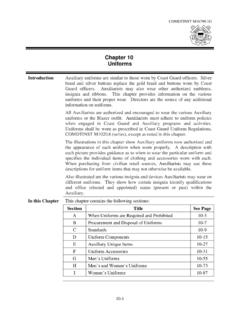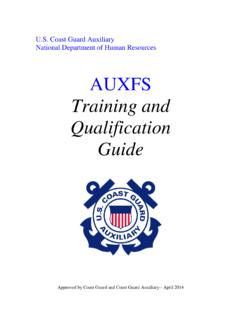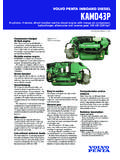Transcription of Metal Detecting Florida's 1715 East Coast Treasure …
1 Metal Detecting Florida's 1715 east Coast Treasure Wrecks Update: June 17, 2017 Assembled by: Lee Wiese Metal Detecting Hobby Talk Page 1 of 90 Rev: P Metal Detecting Florida's 1715 east Coast Treasure Wrecks Rev: H - Complete Update on January 04, 2014 Rev: J - Updated with florida Beach Views & Protect Turtles Statement June 17, 2014 Rev: K - Treasure Article Links Added in the Appendix July 31, 2014 Rev: L - More than $1M in gold discovered off Fort Pierce from 1715 Treasure fleet Rev: M - Treasure hunter reveals he found $ million in gold coins off Wabasso Rev: N - Web-link Update Rev: O - Brevard Treasure Hunter Larry Bacola Discovers Gold Rings From 1715 Sunken Fleet Appendix Sept.
2 16, 2016 Rev: P Remove reference to 50 year Detecting Florida's 1715 east Coast Treasure Wrecks Update: June 17, 2017 Assembled by: Lee Wiese Metal Detecting Hobby Talk Page 2 of 90 Rev: P Metal Detecting the 1715 Treasure Fleet Disclaimer: The sources for this 1715 Fleet information package is derived from personal knowledge, websites and various books. In some cases the information found has required the author to interpret or make a value judgment on the validity of the material so there may be errors or disconnects in the article's material. It is suggested that this material should be considered as a reference guide only and the best avenue to follow is to seek a second source for this information.
3 So take the time and do your own independent research on the 1715 Fleet. The article is written for detectorist that live in the other 49 states in the since those living in florida are already very well educated on the 1715 Fleet accessibility. The florida Treasure Coast is well published with many sources available such as: 1715 only websites and shipwreck books detailing the Fleet's history, the destruction of the Fleet and the Treasure lost / salvaged. So a detailed 1715 Fleet history will not be part of this article. As someone that lives outside of the state of florida , knowing where the 1715 Fleet is located and how to access it can be of great help to any detectorist before going on a Metal Detecting trip to florida . The wreck site detail found in the next 38 pages will provide the detectorists with the necessary information to try their Detecting skill on the Treasure Coast beaches.
4 Knowing in advance where the fleet is located, finding access points and knowing where to detect can be a great advantage to an outsider. Therefore, the article will be rather short with a greater emphasis placed on providing individual wreck site diagrams or maps. These diagrams will include the GPS coordinates for the wreck site lease area, A1A access point to the wreck site and other identifying land marks associated with the site. A single florida A1A Highway diagram or map line with a summary of individual GPS beach access points and GPS wreck location coordinates is also included. Again, each of the individual diagrams or maps provide GPS Latitude and Longitude coordinates for easy identification. A GPS that uses Latitude and Longitude coordinates is a requirement for using the information provided in this article.
5 By using the GPS coordinates one can start either from the most North position or South position of the wreck site list. Just input the given coordinates in to a GPS, which in turn will create a very detailed Plot or Navigation route to follow. Therefore, by using the GPS coordinates you can travel the complete 1715 Treasure Coast area and be informed by your GPS's alert system as you approach a wreck site or an access point to a wreck site. No longer is there a need to trace mileage from a given point to a wreck site location. There are a number of other wreck sites listed in the article that are not part of the 1715 Fleet but may have carried Spanish Treasure and wrecked at a much earlier date than1715. There are also wreck sites that are much newer and have very little or no Treasure content but in the past have been identified as part of the Treasure Coast in various publications.
6 So for clarity and consistency they are also listed in this article and on the maps. Sometimes you may find GPS coordinates for these wreck sites along with other wreck site information. Following is a very short description of the 1715 Fleet with links to a number of websites that can provide the reader with much more detail on the fleet s creation, its journey and finally its destruction by the 1715 hurricane. If you're interested in Fleet detail take a look at these websites, since this article is primarily focused on providing the Metal detectorist with the necessary information to get to a beach area adjacent to the actual wreck sites. 1715 Fleet Background: On July 31, 1715 eleven of the twelve Spanish ships sailing from Havana to Spain were wrecked by a violent hurricane on the east Coast of florida from St.
7 Lucie to Cape Canaveral. Seven of these Spanish Treasure laden ships were scattered over the reefs from South of Fort Pierce to the Sebastian Metal Detecting Florida's 1715 east Coast Treasure Wrecks Update: June 17, 2017 Assembled by: Lee Wiese Metal Detecting Hobby Talk Page 3 of 90 Rev: P Inlet. Thus, this part of Florida's Atlantic east Coast is known as the famous Treasure Coast . 1715 Fleet Ships Believed to have been Found are: 1 - Nuestra Senora de la Regla - Cabin Wreck Site 2 - Santo Cristo de San Roman - Corrigan's Wreck Site 3 - Nuestra Senora del Carmen - Rio Mar Wreck Site 4 - Nuestra Se ora de La Popa - La Holandesa Wreck Site 5 - Nuestra Senora del Rosario - Sandy Point Wreck Site 6 - Urca de Lima - Wedge Wreck Site - Note: This is a State Archaeology Site 7 - Nuestra Senora de las Nieves - Douglas Beach Wreck or Gold Wreck or Colored Beach Site Ships of the 1715 Fleet Never Located are the.
8 8 - Maria Galante 9 - El Senor San Miguel a 22 cannon frigate (Possibly wrecked off Amelia Island, florida ) - See Appendix 10 - El Cievro also known as La Galleria (Possibly wrecked off Amelia Island, florida ) 11 - Nuestra Senora de la Concepcion - See Appendix 12 - Griffon made it safely and went on to France. Spanish coins of all types (Gold and Silver) started to be found on the beaches in the 1950s after strong Nor'easters or a violent hurricane. This lead to key individuals to research as to how and where these coins came about being on the east Coast florida beaches. The research resulted in early development (1960) of salvage teams and the search for Spanish Treasure begins in earnest. It has been over 50 years and the search continues. Website Links to the 1715 Fleet History: Mel Fishers 1715 Fleet History We have Pirate Treasure on our beaches Spanish Camp Site of the 1715 Plate Fleet Wreck In 1987, Urca de Lima became florida s first Underwater Archaeological Preserve.
9 Metal Detecting the Wreck Sites: A Very Brief florida State Law Overview: You are allowed to hunt the beaches from the foot of the Dune to the low tide line and that includes the beaches adjacent to the 1715 Fleet of Spanish shipwrecks. Inside State parks you are required to get written permission from the Park Ranger before you detect in the park. Some State Parks will allow Metal detectors in the park. Do not bring your Metal detector into a National Park in florida , this includes all beaches and waters adjacent to the National Park. In June 2005, the state of florida did away with the Isolated Finds Program. The Isolated Finds Program provided the Treasure hunter with the ability to keep a find as long as the state was provided with the location of the find. You can dive on Treasure Coast wrecks, however, you must NOT have a Metal detector in the ocean lease site, and you must stay 300 feet away from dive boats that are working the lease area.
10 Do NOT bring a Metal detector within the 3,000 yard radius lease area while in the water. Check the GPS coordinates listed in this Metal Detecting Florida's 1715 east Coast Treasure Wrecks Update: June 17, 2017 Assembled by: Lee Wiese Metal Detecting Hobby Talk Page 4 of 90 Rev: P article for the various site leases. It is very wise to do your own research from a second or third source before visiting a wreck site to validate the GPS coordinates and restrictions for the site. How and Where to Metal Detect a Wreck Site: There have been very rare incidences of a detectorist walking out onto one of the Treasure Coast Beaches and finding Treasure . However, having said that the best time to Metal detect these beaches is during or directly after a strong Nor'easter or hurricane.







